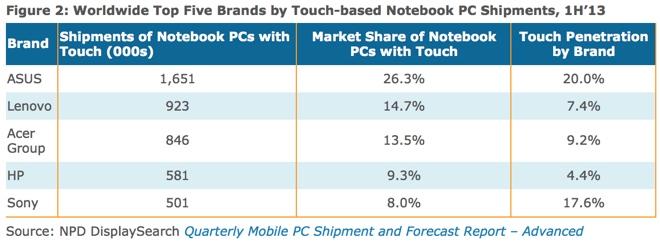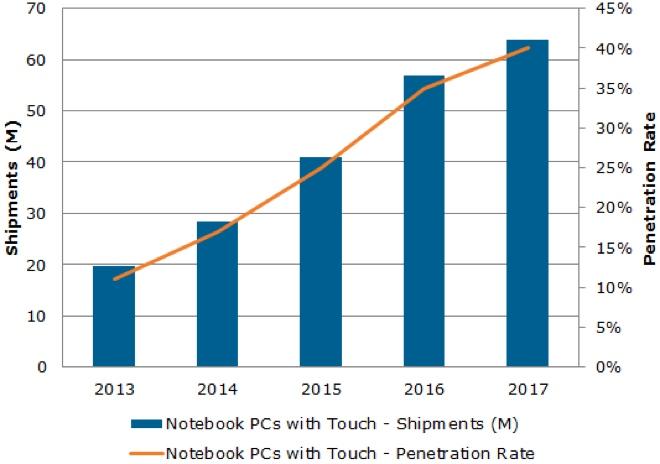Apple has famously compared convertible Windows tablets to combining a toaster and a refrigerator, but competitors are still increasing their output of touchscreen notebooks in hopes of turning around slumping PC sales.
The latest data released Tuesday by NPD DisplaySearch forecasts that 19.8 million touch-enabled notebook PCs will ship this year. That would account for about 11 percent of all notebooks shipped in 2013.
Touchscreen notebook shipments have also grown throughout the year, from just 7 percent in the first half of 2013. Manufacturers have been most likely to put touchscreens on their "ultra-slim" PC models, giving users the option of tablet-style utilization.
Asus has been the most enthusiastic in embracing touchscreens on notebooks, with 20 percent of its laptops now sporting touch-capable displays. That's also helped Asus to carve out a 26.3 percent share of the touch notebook PC market, according to NPD.
For Sony, 17.6 percent of its notebooks shipped worldwide are touch-capable, but the Japanese electronics maker has managed to take just an 8 percent share of global notebook PCs with touch. In contrast, just 7.4 percent of Lenovo's total notebook shipments sport touchscreens, yet it has a 14.7 percent market share.
One company that has signaled it has no plans to add touchscreens to its existing notebook lineup is Apple, as its executives have panned Windows 8 "convergence" PCs that aim to offer the benefits of both a laptop and a tablet. Apple has instead kept its iPad and MacBook lineups separate, with different operating systems and interfaces suited to each device.
In one of his company's quarterly earnings conference calls in 2012, Apple Chief Executive Tim Cook compared hybrid tablet-notebook devices to that of selling a refrigerator with toaster functions tacked on the side. Such combinations are not "pleasing to the user," he said.
"Anything can be forced to converge," Cook said. "But the problem is that the products are about tradeoffs. You begin to make tradeoffs to the point where what you have left at the end of the day doesn't please anyone."
Though Apple doesn't see much of a market for notebook PCs with touchscreens, NPD still projects that their share of shipments will grow in the coming years. The company's forecast sees notebook PCs with touch reaching a penetration rate north of 40 percent by the year 2017.
 Neil Hughes
Neil Hughes








-m.jpg)






 Charles Martin
Charles Martin
 Christine McKee
Christine McKee
 Wesley Hilliard
Wesley Hilliard
 Malcolm Owen
Malcolm Owen
 Andrew Orr
Andrew Orr
 William Gallagher
William Gallagher
 Sponsored Content
Sponsored Content








22 Comments
I have to admit, I've touched my Mac screen after being away from it for awhile, only using my iPhone, but that feeling quickly goes away. I look at the convertibles as a product that isn't good in either version. If it wants to be a great tablet, then it shouldn't need a full size keyboard. If it wants to be a great laptop, it shouldn't need to rely on a bunch of touch features. That being said, even Apple is getting away from using "archaic" (sarcasm) entry devices like a mouse by adding more gestures to the trackpad. Will they end up converting MacBook Pros to a touchscreen for some things, negating the need for the trackpad? The funny part about all those convertible ads is the first thing they do it snap on a keyboard (how long will the snap work?). I see devices like this as requiring the keyboard, using it without being secondary. These PC companies can continue to try and sell products but I wonder how long they can stay in business selling and giving away products that are out with the next week's garbage.
iPad + [ logitec ] = touchscreen laptop. Nice but niche.
My friend was all excited about getting one of these (Asus)... but found that the touchscreen didn't work well in practice or offer much besides awkwardness. It's a fun bullet point to claim, though! My convertible notebook of choice is an iPad with (less than 1/4 of the time) a keyboard cover attached.
A laptop needs needs a touchscreen like a fish needs a bicycle.
"Gestures" have a better chance of being incorporated into Laptops and Desktop computers than "Touch".
"Gestures" could make use of their already built in iSight camera. There's no need to smudge your screen.
Actually "Gestures" could be integrated into the iPad as well. Some cooking apps are already taking advantage of this: One has to wave at the screen in order to progress to the next step.